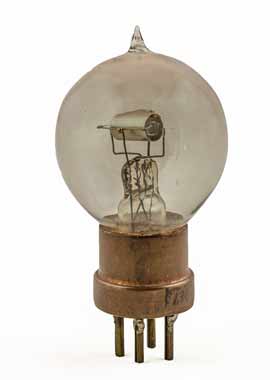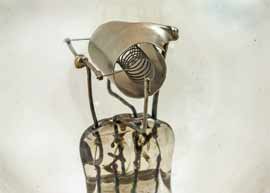R-Type Valve
The R-type valve was one of the first valves used extensively in early wireless equipment. It was manufactured by several different manufacturers.
History of the Valve / Tube Includes:
History overview
Early discoveries
Fleming's oscillation valve
de Forest's Audion
Development of the basic idea
R-type valve
6L6 valve
EF50 valve
The R-type valve was one of the early success stories of the thermionic valve or vacuum tube business. It was designed and primarily manufactured in the UK, although some were manufactured outside the UK.
The R valve was a basic directly heated triode and one of the most successful of the early valves and was manufactured by a number of different companies.
R-valve development
During the First World War, great pressure was placed upon the manufacturers of wireless and other electronic equipment for better performance. The performance of thermionic valves or vacuum tubes of the day left much to be desired and as a result much activity was placed upon developing improved valves.
The British R-type valve has its parentage in the French, type TM valve. The British Thomson Houston Company had been studying how the performance of the TM valve produced by the French Telegraphie Militaire.
The Thomson Houston Company developed a high vacuum receiving valve that was given the designation R-type. This R-type valve was manufactured by virtually all British valve manufacturers even though some used different designations for it.

R valve construction
The R valve was manufactured using an anode of sheet nickel in the form of a cylinder 0.625 inches (16mm) long and 0.4 inches (10mm) in diameter. The grid was formed from 0.005 inch (0.13mm) wire formed into an 11 turn helix about 0.2 inches (5mm) in diameter. The filament / cathode was made of tungsten.
The electrode structure was assembled and held in place using a glass pinch.
The whole assembly was then contained within a highly evacuated glass balloon. This was typically just under 3.5 inches (88mm) in diameter and the valve base used as a B4.

R-type valve performance
In view of the fact that the R-valve manufacturing techniques and processes were not defined to a very exacting tolerance, the performance varied considerably between different batches and also between different manufacturers. However as a guide to the performance the R valve typically possessed the following characteristics:
| Typical R-Valve Characteristics | |
| Parameter | Specification |
| Heater voltage Vh | 4V |
| Heater current Ah | 0.7A |
| Max anode voltage Va | 100 |
| Anode resistance, ra | 35 - 40kΩ |
| Mutual conductance, gm | 0.26 |
| Amplification factor, µ | ~9 |
| Typical R-Valve Base Connections | |
| Connection | Pin Number |
| Anode, a | 1 |
| Control grid, g1 | 2 |
| Heater / Cathode, f | 3 |
| Heater / Cathode, f | 4 |
The base style for the R-type valve was B4
R valve developments
The R-type valve was a particularly successful development. Building on its success a number of variants were developed to provide improved performance.
- R2 valve: This was a soft valve that was similar in construction to the French type TM valve. The envelope was filled with nitrogen to a pressure of 0.06 mm mercury. The details of the valve were released to a number of manufacturers and the first production of this valve was delivered in June 1917 by the General Electric Company.
- R3 valve: No manufacture of a vale with this designation has been found. It may have appeared in development, but not finalised or released.
- R4 valve: The R4 valve was developed to overcome some of the issues experienced with the basic R valve. In particular the R-type valve would not oscillate over the complete frequency range needed for some naval work. Various changes to dimensions were made, notably the grid was brought closer to the filament / cathode. Also improvements were made to provide a higher level of reliability enabling the life to be extended from around 1500 hours for an R vale to around 8000 hours for the R4 valve.
- R5 valve: The R5 version of the R valve was a high vacuum receiving valve. Following the general design concepts created by captain H J Round. After some development issues this form of R valve it was introduced. The ratio of the diameter to length of the anode was greater than for other forms of R valve to reduce the anode grid capacitance.
- R6 valve: Although there are some records of the R6 valve, this never progressed beyond the experimental stages.
- R7 valve: This form of R valve was made around 1920 by the Mullard Radio Valve Company.
- R8 valve: Although the R8 version of the R valve existed it was unlikely to have gone much beyond the experimental stages as no data is available on it, although at least one prototype does exist.
The R-type valve series was particularly successful and was manufactured in large quantities. Its performance improved with successive variants.
 Written by Ian Poole .
Written by Ian Poole .
Experienced electronics engineer and author.
More History:
Radio history timeline
History of the radio
Ham radio history
Coherer
Crystal radio
Magnetic detector
Spark transmitter
Morse telegraph
Valve / tube history
PN junction diode invention
Transistor
Integrated circuit
Quartz crystals
Classic radios
Mobile telecoms history
Vintage mobile phones
Return to History menu . . .



